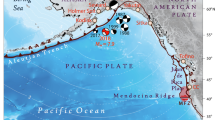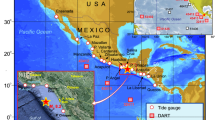Abstract
On January 15, 2022 the Hunga Tonga Hunga Ha’apai volcano erupted violently, generating a significant tsunami that was observed around the world. This is the first volcanic tsunami that has been observed worldwide by the modern deep- and shallow-water hydrodynamic instrument network. Here we study deep water DART buoy and coastal tide gauges recordings using waveform stacking, amplitude analysis, and spectral analysis. We find that there are potentially as many as three distinct phases to the tsunami each corresponding to different generation mechanisms. Most sites observed an arrival with a propagation speed of ~ 305–310 m/s that we deduced is likely to be an atmospheric Lamb wave with a ~ 40 min period. We find that this feature has a weakly azimuthally-dependent radiation pattern. We also find secondary phases which range in propagation speed from ~ 150 to 205 ms−1. Analysis of their amplitudes and variability in propagation speeds in the waveforms tacks, their decay, and their frequency domain behavior leads us to posit that they represent a complex amalgam of traditional tsunami and atmospheric effects such as internal gravity waves. Overall, from this analysis we find no evidence that processes at the volcanic edifice, such as caldera collapse, land sliding, or pyroclastic density currents, are the dominant tsunamigenic source in the far field. Finally, we also argue that amplification of tsunami wave heights around the coastal areas of the Pacific basin may be due to the combined effects of processes like those seen in meteotsunamis such as Proudman resonance induced by the Lamb wave front, with various coastal areas seeing also effects from Greenspan and shelf resonance. We show a comparison of the event to the last great basin tsunami the M9 Tohoku-oki earthquake, and discuss how, while the amplitudes of the Hunga Tonga tsunami are smaller than other basin-wide events, the worldwide nature, and atmospherically driven forcing of it pose unique challenges to hazards forecasts and warning.









Similar content being viewed by others
Data Availability Statement
DART data was accessed from two different API’s: NOAA and GNS New Zealand. Information concerning the GNS New Zealand GeoNet API and DART data availability can be found at the following: https://github.com/GeoNet/data-tutorials/blob/main/TILDE/README.md. The DOI for GeoNet’s DART is: https://doi.org/10.21420/8tcz-tv02. NOAA DART data is available from the following: http://www.ndbc.noaa.gov/dart_data.php. The data used in this study are archived on GitHub (https://github.com/ssantellanes/Hunga_Tonga_Water_Level) and archived on Zenodo (Santellanes et al., 2022).
References
Arai, N., Iwakuni, M., Watada, S., Imanishi, Y., Murayama, T., & Nogami, M. (2011). Atmospheric boundary waves excited by the tsunami generation related to the 2011 great Tohoku-Oki earthquake. Geophysical Research Letters. https://doi.org/10.1029/2011GL049146
Bernard, E., & Titov, V. (2015). Evolution of tsunami warning systems and products. Philosophical Transactions of the Royal Society a: Mathematical, Physical and Engineering Sciences, 373(2053), 20140371.
Blom, P. S., Dannemann, F. K., & Marcillo, O. E. (2018). Bayesian characterization of explosive sources using infrasonic signals. Geophysical Journal International, 215(1), 240–51. https://doi.org/10.1093/gji/ggy258
Carvajal, M., Sepúlveda, I., Gubler, A., & Garreaud, R. (2022). Worldwide signature of the 2022 Tonga volcanic tsunami. Geophysical Research Letters, 49, e2022GL098153.
CO-OPS 1-minute Water Level Data - Cite as: Center for Operational Oceanographic Products and Services (CO-OPS). (2007). CO-OPS 1-minute Tsunami water level data. NOAA National Centers for Environmental Information. https://doi.org/10.7289/V59884XF
Flanders Marine Institute (VLIZ); Intergovernmental Oceanographic Commission (IOC) (2022): Sea level station monitoring facility. Accessed at http://www.ioc-sealevelmonitoring.org on 2022–03–14 at VLIZ. DOI: https://doi.org/10.14284/482
Fujii, Y., Satake, K., Sakai, S. I., Shinohara, M., & Kanazawa, T. (2011). Tsunami source of the 2011 off the Pacific coast of Tohoku earthquake. Earth, Planets and Space, 63(7), 815–820.
Harkrider, D., & Press, F. (1967). The Krakatoa air—sea waves: an example of pulse propagation in coupled systems. Geophysical Journal International, 13(1–3), 149–159.
Hedlin, M. A. H., Walker, K., Drob, D. P., & de Groot-Hedlin, C. D. (2012). Infrasound: connecting the solid earth, oceans, and atmosphere. Annual Review of Earth and Planetary Sciences, 40, 327–354.
Heidarzadeh, M., Gusman, A., Ishibe, T., Sabeti, R., & Šepić, J. (2022). Estimating the eruption-induced water displacement source of the 15 January 2022 Tonga volcanic tsunami from tsunami spectra and numerical modelling. Ocean Engineering, 261, 112165.
Kohler, M. D., Bowden, D. C., Ampuero, J. P., & Shi, J. (2020). Globally scattered 2011 Tohoku tsunami waves from a seafloor sensor array in the northeast Pacific ocean. Journal of Geophysical Research: Solid Earth, 125(11), e2020JB20221.
Kubota, T., Saito, T., & Nishida, K. (2022). Global fast-traveling tsunamis driven by atmospheric lamb waves on the 2022 Tonga eruption. Science., 377, eabo364.
Lighthill, M. J., & Lighthill, J. (2001). Waves in fluids. Cambridge University Press.
Matoza, R. S., Fee, D., Assink, J. D., Iezzi, A. M., Green, D. N., Kim, K., & Wilson, D. C. (2022). Atmospheric waves and global seismoacoustic observations of the January 2022 Hunga eruption, Tonga. Science, eeeeeeeeeee.
Monserrat, S., Vilibić, I., & Rabinovich, A. B. (2006). Meteotsunamis: atmospherically induced destructive ocean waves in the tsunami frequency band. Natural Hazards and Earth System Sciences, 6(6), 1035–1051.
Nishida, K., Kobayashi, N., & Fukao, Y. (2014). Background lamb waves in the earth’s atmosphere. Geophysical Journal International, 196(1), 312–316.
Nomanbhoy, N., & Satake, K. (1995). Generation mechanism of tsunamis from the 1883 Krakatau Eruption. Geophysical Research Letters, 22(4), 509–512. https://doi.org/10.1029/94GL03219
Okal, E. A., & Synolakis, C. E. (2003). A theoretical comparison of tsunamis from dislocations and landslides. Pure and Applied Geophysics, 160(10–11), 2177–2188. https://doi.org/10.1007/s00024-003-2425-x
Pararas-Carayannis, G. (2003). Near and far-field effects of tsunamis generated by the paroxysmal eruptions, explosions, caldera collapses and massive slope failures of the Krakatau volcano in Indonesia on august 26–27, 1883. Science of Tsunami Hazards.
Paris, R., Wassmer, P., Lavigne, F., Belousov, A., Belousova, M., Iskandarsyah, Y., & Mazzoni, N. (2014). Coupling eruption and tsunami records: the Krakatau 1883 case study. Indonesia. Bulletin of Volcanology, 76(4), 1–23.
Press, F., & Harkrider, D. (1966). Air-sea waves from the explosion of Krakatoa. Science, 154(3754), 1325–1327.
Prieto, G. A., Parker, R. L., & Vernon, F. L. (2009). A FORTRAN 90 library for multitaper spectrum analysis. Computational Geoscience, 35, 1701–1710. https://doi.org/10.1016/j.cageo.2008.06.007
Rabinovich, A. B. (1997). Spectral analysis of tsunami waves: separation of source and topography effects. Journal of Geophysical Research: Oceans, 102(C6), 12663–12676.
Revelle, D. O., & Whitaker, R. W. (1996). Lamb waves from airborne explosion sources: viscous effects and comparisons to ducted acoustic arrivals. Los Alamos, NM (United States): Los Alamos National Lab (LANL).
Ruppert, J. H., Jr., Koch, S. E., Chen, X., Du, Y., Seimon, A., Sun, Y. Q., Wei, J., & Bosart, L. F. (2022). Mesoscale gravity waves and midlatitude weather: a tribute to Fuqing Zhang. Bulletin of the American Meteorological Society, 103(1), E129–E156.
Saito, T., Inazu, D., Miyoshi, T., & Hino, R. (2014). Dispersion and nonlinear effects in the 2011 Tohoku-Oki earthquake tsunami. Journal of Geophysical Research: Oceans, 119(8), 5160–5180.
Santellanes, S. R., Ruiz-Angulo, A. & Melgar, D. (2022). ssantellanes/ Hunga_Tonga_Water_Level: First release (Version v1.0.0). Zenodo. https://doi.org/10.5281/zenodo.6886365
Satake, K., Fujii, Y., Harada, T., & Namegaya, Y. (2013). Time and space distribution of coseismic slip of the 2011 Tohoku earthquake as inferred from tsunami waveform data. Bulletin of the Seismological Society of America, 103(2B), 1473–1492.
Satake, K., Heidarzadeh, M., Quiroz, M., & Cienfuegos, R. (2020). History and features of trans-oceanic tsunamis and implications for paleo-tsunami studies. Earth-Science Reviews, 202, 103112.
Watada, S. (2009). Radiation of acoustic and gravity waves and propagation of boundary waves in the stratified fluid from a time-varying bottom boundary. Journal of Fluid Mechanics, 627, 361–377.
Watada, S., and Kanamori, H. (2010). Acoustic resonant oscillations between the atmosphere and the solid earth during the 1991 Mt. Pinatubo eruption. Journal of Geophysical Research: Solid Earth, 115(B12).
Yokoyama, I. (1987). A scenario of the 1883 Krakatau tsunami. Journal of Volcanology and Geothermal Research, 34(1–2), 123–132.
Yuen, D. A., Scruggs, M. A., Spera, F. J., Zheng, Y., Hu, H., McNutt, S. R., Thompson, G., Mandli, K., Keller, B. R., Wei, S. S., & Peng, Z. (2022). Under the surface: pressure-induced planetary-scale waves, volcanic lightning, and gaseous clouds caused by the submarine eruption of Hunga Tonga-Hunga Ha’apai volcano provide an excellent research opportunity. Earthquake Research Advances., 2, 100134.
Acknowledgements
We acknowledge the New Zealand GeoNet project and its sponsors EQC, GNS Science, LINZ, NEMA and MBIE for providing data/images used in this study. The work of their engineers and software developers allowed for deep insights into their DART data. Their work provided us with extremely high quality and performance data unparalleled in other areas of the DART network. We also acknowledge Josef Dufek and Thomas Giachetti for providing insights into the processes involved with volcanic eruptions. We also acknowledge the Flanders Marine Institute (VLIZ); Intergovernmental Oceanographic Commission (IOC); Sea level station monitoring facility for the tide gauge data as well as the Center for Operational Oceanographic Products and Services (CO-OPS/NOAA) for the historical tide gauge data.
Funding
National Aeronautics and Space Administration, 80NSSC19K1104.
Author information
Authors and Affiliations
Contributions
SS and DM wrote the main manuscript text. SS made the figures, with DM and ARA providing feedback on the style of the figures. ARA provided the tide gauge analysis. SS provided the DART analysis and further analyzed the tide gauge data. SS wrote the response to reviewer #1. SS and DM wrote the response to reviewer #2. ARA provided feedback on how to address some of the figure edits in response to reviewer comments.
Corresponding author
Ethics declarations
Conflict of interest
The authors declare no competing interests.
Additional information
Publisher's Note
Springer Nature remains neutral with regard to jurisdictional claims in published maps and institutional affiliations.
Rights and permissions
Springer Nature or its licensor (e.g. a society or other partner) holds exclusive rights to this article under a publishing agreement with the author(s) or other rightsholder(s); author self-archiving of the accepted manuscript version of this article is solely governed by the terms of such publishing agreement and applicable law.
About this article
Cite this article
Santellanes, S.R., Ruiz-Angulo, A. & Melgar, D. Tsunami Waveform Stacking and Complex Tsunami Forcings from the Hunga-Tonga Eruption. Pure Appl. Geophys. 180, 1861–1875 (2023). https://doi.org/10.1007/s00024-022-03200-y
Received:
Revised:
Accepted:
Published:
Issue Date:
DOI: https://doi.org/10.1007/s00024-022-03200-y




